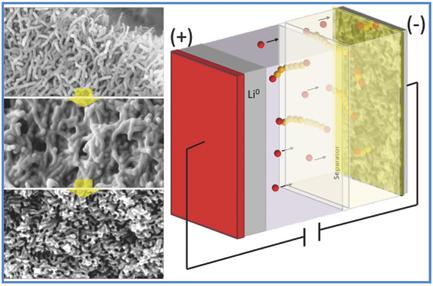当前位置:
X-MOL 学术
›
Adv. Mater. Interfaces
›
论文详情
Our official English website, www.x-mol.net, welcomes your
feedback! (Note: you will need to create a separate account there.)
Phase Inversion Strategy to Fabricate Porous Carbon for Li‐S Batteries via Block Copolymer Self‐Assembly
Advanced Materials Interfaces ( IF 4.3 ) Pub Date : 2018-01-11 , DOI: 10.1002/admi.201701116 Soumyadip Choudhury 1, 2 , Dieter Fischer 1 , Petr Formanek 1 , Manfred Stamm 1, 2 , Leonid Ionov 3, 4
Advanced Materials Interfaces ( IF 4.3 ) Pub Date : 2018-01-11 , DOI: 10.1002/admi.201701116 Soumyadip Choudhury 1, 2 , Dieter Fischer 1 , Petr Formanek 1 , Manfred Stamm 1, 2 , Leonid Ionov 3, 4
Affiliation

|
In this paper, an easy, facile way of preparing porous carbon cathode for lithium–sulfur batteries with superior cycle stability is demonstrated. The highly porous cathode is fabricated by using self‐assembled nanostructured block copolymer as template. The block copolymer template is formed via phase inversion route followed by filling the empty spaces by oligomeric phenolic resin, thermopolymerization of the resin, and finally by carbonization. Semi‐gelled film of self‐assembled block copolymer is immersed in solution of nonsolvent mixture. After washing away of low molecular additive, a highly porous mat is generated. After successful filling with carbon precursor inside the template, crosslinking and carbonization under inert atmosphere result in a highly porous carbon material, which is further hybridized with sulfur via melt diffusion of elemental sulfur. This new fabrication route of template formation by phase inversion requires no solvent/thermal annealing step to generate nanostructure aided by block copolymer. The cathode material shows excellent cycle stability over 240 charging–discharging cycles, rate handling over 100 cycles.
中文翻译:

通过嵌段共聚物自组装为Li-S电池制造多孔碳的相转化策略
在本文中,展示了一种简便,便捷的制备锂硫电池多孔碳阴极的方法,该阴极具有出色的循环稳定性。高度多孔的阴极是使用自组装的纳米结构嵌段共聚物作为模板制成的。嵌段共聚物模板通过相转化途径形成,随后通过低聚酚醛树脂填充空隙,树脂的热聚合,最后通过碳化。将自组装嵌段共聚物的半凝胶薄膜浸入非溶剂混合物的溶液中。洗掉低分子添加剂后,会生成高度多孔的垫子。在模板内部成功填充碳前体后,在惰性气氛下进行交联和碳化会形成高度多孔的碳材料,通过元素硫的熔融扩散与硫进一步杂交。通过相转化形成模板的这种新的制备途径不需要溶剂/热退火步骤以生成由嵌段共聚物辅助的纳米结构。阴极材料在240个充放电循环中表现出出色的循环稳定性,在100个循环中具有出色的速率处理能力。
更新日期:2018-01-11
中文翻译:

通过嵌段共聚物自组装为Li-S电池制造多孔碳的相转化策略
在本文中,展示了一种简便,便捷的制备锂硫电池多孔碳阴极的方法,该阴极具有出色的循环稳定性。高度多孔的阴极是使用自组装的纳米结构嵌段共聚物作为模板制成的。嵌段共聚物模板通过相转化途径形成,随后通过低聚酚醛树脂填充空隙,树脂的热聚合,最后通过碳化。将自组装嵌段共聚物的半凝胶薄膜浸入非溶剂混合物的溶液中。洗掉低分子添加剂后,会生成高度多孔的垫子。在模板内部成功填充碳前体后,在惰性气氛下进行交联和碳化会形成高度多孔的碳材料,通过元素硫的熔融扩散与硫进一步杂交。通过相转化形成模板的这种新的制备途径不需要溶剂/热退火步骤以生成由嵌段共聚物辅助的纳米结构。阴极材料在240个充放电循环中表现出出色的循环稳定性,在100个循环中具有出色的速率处理能力。











































 京公网安备 11010802027423号
京公网安备 11010802027423号